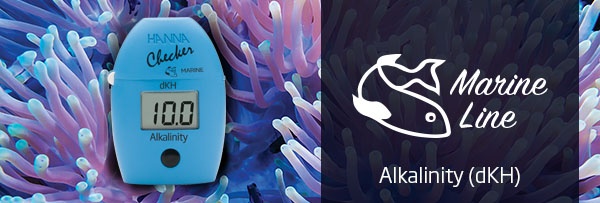
Alkalinity is important in saltwater aquariums for a number of reasons. Proper alkalinity (142-215 ppm or 8-12 dKH) is vital for coral calcification and skeletal formation; it prevents pH swings, alkalinity burn, coral bleaching, and tissue loss; and it improves equipment performance. It is best to test for alkalinity weekly, or as needed depending on your dosing schedule, in order to maintain a healthy aquarium. Simply put, the greater the tank's alkalinity, the greater its ability to prevent rapid swings in pH.
With the Hanna Marine Alkalinity (dKH) Checker® HC - HI772 and (ppm) Checker® HC - HI755 you get an easy-to-read digital alkalinity level in either degrees Karbonathärte (dKH) or parts per million (ppm). No more guessing at subtle shifts in color!

 In addition to being easy and accurate, the full line of Hanna Marine Checkers eliminate the hassle of always having to buy new test kits. When you run low on the supplied HI755-26 reagent (25 tests per bottle), just purchase a refill pack and you will be back to testing in no time.
In addition to being easy and accurate, the full line of Hanna Marine Checkers eliminate the hassle of always having to buy new test kits. When you run low on the supplied HI755-26 reagent (25 tests per bottle), just purchase a refill pack and you will be back to testing in no time.
How to Use the Hanna Marine Alkalinity (dKH) Checker HC - HI772
Video: How to Use the Marine Alkalinity (dKH) Checker
Note that the HI772 gives readings in dKH.- To convert from dKH alkalinity to ppm, multiply the result by 17.86.
- To convert from ppm to meq/L, multiply by 0.358.
How to Use the Hanna Marine Alkalinity (ppm) Checker HC- HI755
Video: How to Use the Marine Alkalinity (ppm) Checker
Note that the HI1755 gives readings in ppm.
- To convert from ppm to dKH alkalinity, simply multiply the result by 0.056.
- To convert from ppm to meq/L, multiply by 0.02.
Everything You Need to Start Testing
Our marine alkalinity checkers are supplied as a complete test kit. The kit includes:


- Hanna Marine Alkalinity (dKH) Checker HC - HI772 OR Hanna Marine Alkalinity (ppm) Checker HC- HI755
- Two sample cuvettes with caps
- Reagents for 25 tests
- One 1mL syringe with tip
- One AAA Battery
- Water resistant case to store all testing items
- The HI772 instruction manual or HI755 instruction manual and laminated quick reference guide. The reference guide includes the testing instructions and tips for accurate measurement. It’s the perfect companion to have while you are performing measurements.
How to test:
The Hanna Marine Alkalinity (dKH) Checker and Hanna Marine Alkalinity (ppm) Checker are designed to make testing quick and easy.
- Press the button to power the meter on. When Add C1 appears on the screen, you are ready to begin testing.
- Fill a cleaned cuvette to the 10mL line with sample and fasten the cap.
- Using a microfiber cloth, wipe the cuvette to remove any oils or fingerprints from the glass. Then place the cuvette into the checker and close the lid, making sure it is completely closed. It is important to make sure that the lid is completely closed for an accurate reading.
- Press the button.
- Once the screen shows Add C2, use the syringe to extract 1mL of reagent from the reagent bottle. Once the reagent has been added, cap the cuvette and invert five times to mix.
- Wipe the cuvette of any oils or fingerprints and place back into the meter.
- Press the button, and the meter will display the alkalinity in either degrees Karbonathärte (dKH) or parts per million (ppm), depending on which Checker you’ve purchased.
Why Test Alkalinity?
Alkalinity is a system’s ability to buffer its pH as acids are introduced. In saltwater systems alkalinity is present in two main forms: carbonate (CO32-) and bicarbonate (HCO3-). It’s important to check for alkalinity in reef aquariums because it’s vital to the calcification of corals and skeletal formation of many marine organisms. The recommended range for alkalinity in reef aquariums is between 142-215ppm or 8-12 dKH.
There are many solutions and chemicals you can add to a reef tank to increase alkalinity, such as sodium bicarbonate, Kalkwasser (Kalk/limewater) or various commercial premixes. Too high alkalinity can be damaging to organisms in an aquarium and even cause alkalinity burn, coral bleaching, or tissue loss. Additionally, a high alkalinity level puts the tank at risk for calcium carbonate precipitation (limestone formation). This precipitation can sometimes damage equipment and cause heaters or pumps to perform poorly. When the alkalinity drops too low your tank is susceptible to detrimental pH swings, causing organisms that utilize alkalinity to be unable to take in what they need.
The Limits of Traditional Color-Change Test Kits
Many test kits on the market rely on a color change that needs to be judged by eye. These are notoriously inaccurate and difficult to use, especially in the lower ranges. The Hanna Marine Alkalinity (dKH) Checker HC - HI772 and (ppm) Checker HC - HI755 bridge the gap between simple chemical test kits and professional instrumentation. The one-button design makes testing for calcium a cinch to use.
Learn More About Our Full Marine Line of Checkers
- Hanna Marine Calcium Checker HC - HI758 | Calcium Reagents HI758-26
- Hanna Marine Ultra Low (ULR) Nitrite Checker HC - HI764 | Nitrite ULR Reagents HI764-25
- Hanna Marine Phosphorus ULR Checker HC - HI736 | Phosphorus ULR Reagents HI736-25
Don't Forget Your Alkalinity Reagents!
That's why we've dedicated our blog as a helpful resource for you to use! Catch up on the latest products, explore industry trends, discover testing tips, learn how to improve results, and more. Got questions? Email sales@hannainst.com.

